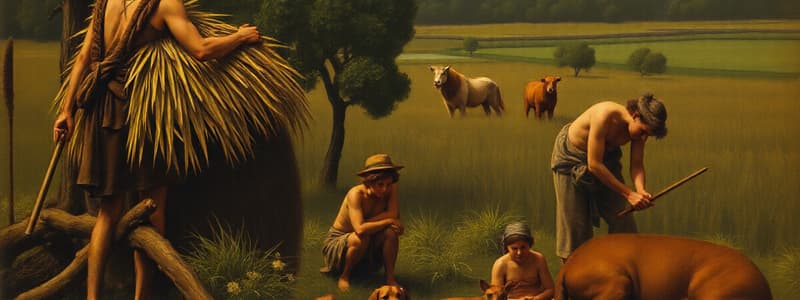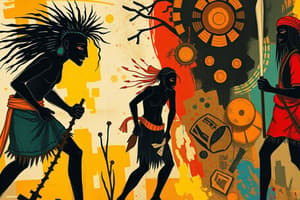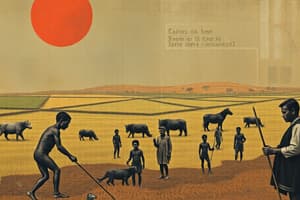Podcast
Questions and Answers
Which of the following is a primary claim made by the author regarding the adoption of agriculture?
Which of the following is a primary claim made by the author regarding the adoption of agriculture?
- It had no significant impact on human societies.
- It was a catastrophic choice that introduced inequality, disease, and despotism. (correct)
- It led to advancements in artistic expression and technological progress.
- It unequivocally improved the quality of life for all humans.
Compared to early farmers, what nutritional advantages did hunter-gatherers typically possess?
Compared to early farmers, what nutritional advantages did hunter-gatherers typically possess?
- A diet lower in protein.
- A diet consisting solely of essential vitamins.
- A diet higher in carbohydrates.
- A more balanced intake of protein and diverse nutrients. (correct)
What evidence from paleopathology challenges the progressivist view of agriculture?
What evidence from paleopathology challenges the progressivist view of agriculture?
- Increased average height in farming communities.
- Skeletal remains indicating a decline in height and increased malnutrition. (correct)
- Skeletal remains showing decreased rates of infectious disease.
- Discovery of advanced medical practices in early agricultural societies
Which factor does the author suggest contributed most to the shift from hunting and gathering to agriculture?
Which factor does the author suggest contributed most to the shift from hunting and gathering to agriculture?
What is the main reason that a focus on leisure time as a critical factor for artistic development might be misguided?
What is the main reason that a focus on leisure time as a critical factor for artistic development might be misguided?
What is a key difference in population dynamics between hunter-gatherer and agricultural societies?
What is a key difference in population dynamics between hunter-gatherer and agricultural societies?
Why were epidemics less common among hunter-gatherer societies compared to early agricultural communities?
Why were epidemics less common among hunter-gatherer societies compared to early agricultural communities?
How did dependence on specific crops make early agricultural societies vulnerable?
How did dependence on specific crops make early agricultural societies vulnerable?
What does the author mean by the adage 'Might makes right' in the context of the agricultural revolution?
What does the author mean by the adage 'Might makes right' in the context of the agricultural revolution?
What analogy does the author use to illustrate the relatively short period that humans have practiced agriculture?
What analogy does the author use to illustrate the relatively short period that humans have practiced agriculture?
Based on the author, what was a typical consequence of the transition to agriculture regarding social structures?
Based on the author, what was a typical consequence of the transition to agriculture regarding social structures?
Which research method is used to understand health conditions in prehistoric populations?
Which research method is used to understand health conditions in prehistoric populations?
What change in stature occurred with the adoption of agriculture, according to skeletal remains from Greece and Turkey?
What change in stature occurred with the adoption of agriculture, according to skeletal remains from Greece and Turkey?
Which of the following is an example of evidence found at Dickson Mounds that shows the negative impacts of agriculture on health?
Which of the following is an example of evidence found at Dickson Mounds that shows the negative impacts of agriculture on health?
How did agriculture inadvertently lead to the increased spread of infectious diseases?
How did agriculture inadvertently lead to the increased spread of infectious diseases?
Why is it difficult to directly compare the lifestyles of modern hunter-gatherers to those of early hunter-gatherers?
Why is it difficult to directly compare the lifestyles of modern hunter-gatherers to those of early hunter-gatherers?
What specific advantage did agriculture provide in terms of population support, compared to hunting and gathering?
What specific advantage did agriculture provide in terms of population support, compared to hunting and gathering?
Which of the following best represents the author's perspective on whether agriculture was inevitable?
Which of the following best represents the author's perspective on whether agriculture was inevitable?
The author challenges the 'progressivist' view of agriculture. What is a characteristic of this view?
The author challenges the 'progressivist' view of agriculture. What is a characteristic of this view?
How did the transition to agriculture impact the division of labor within societies?
How did the transition to agriculture impact the division of labor within societies?
What specific health problem became more prevalent due to the shift towards a diet based on single starchy crops?
What specific health problem became more prevalent due to the shift towards a diet based on single starchy crops?
How did changes in food storage capabilities affect societies after the advent of agriculture?
How did changes in food storage capabilities affect societies after the advent of agriculture?
Based on the text, how did the move to agriculture potentially affect relationships between different groups of people?
Based on the text, how did the move to agriculture potentially affect relationships between different groups of people?
How does the author use the example of the Bushmen to support their argument?
How does the author use the example of the Bushmen to support their argument?
What could an extraterrestrial archaeologist infer about humanity, based on archaeological evidence?
What could an extraterrestrial archaeologist infer about humanity, based on archaeological evidence?
According to the author, what negative development accompanied the population increase that resulted from agriculture?
According to the author, what negative development accompanied the population increase that resulted from agriculture?
How does the author refute the idea that agriculture led to a 'flowering of artistic expression' due to increased leisure time?
How does the author refute the idea that agriculture led to a 'flowering of artistic expression' due to increased leisure time?
Why might plant and animal remains at archaeological sites be useful in understanding the shift to agriculture?
Why might plant and animal remains at archaeological sites be useful in understanding the shift to agriculture?
What do enamel defects in ancient teeth signify to paleopathologists?
What do enamel defects in ancient teeth signify to paleopathologists?
The author cites the Irish potato famine as evidence of what potential pitfall of agriculture?
The author cites the Irish potato famine as evidence of what potential pitfall of agriculture?
How did the nomadic lifestyle of hunter-gatherers contribute to better health outcomes in certain ways?
How did the nomadic lifestyle of hunter-gatherers contribute to better health outcomes in certain ways?
What practice did hunter-gatherers use to space out their childbirths?
What practice did hunter-gatherers use to space out their childbirths?
What does porotic hyperostosis in skeletons indicate?
What does porotic hyperostosis in skeletons indicate?
Which three high-carbohydrate plants comprise the bulk of calories consumed by the human species?
Which three high-carbohydrate plants comprise the bulk of calories consumed by the human species?
Flashcards
Progressivist Perspective
Progressivist Perspective
The idea that human history represents continuous improvement and advancement.
Paleopathology
Paleopathology
The study of disease signs in ancient human remains.
Enamel Defects
Enamel Defects
Defects in tooth enamel, indicating malnutrition during childhood.
Porotic Hyperostosis
Porotic Hyperostosis
Signup and view all the flashcards
Hunter-Gatherer Diet
Hunter-Gatherer Diet
Signup and view all the flashcards
Agricultural Revolution
Agricultural Revolution
Signup and view all the flashcards
Hunter-Gatherers Lifestyle
Hunter-Gatherers Lifestyle
Signup and view all the flashcards
Farmers' dietary risk
Farmers' dietary risk
Signup and view all the flashcards
Disease Spread
Disease Spread
Signup and view all the flashcards
Farming supported higher populations
Farming supported higher populations
Signup and view all the flashcards
Hunting and Gathering
Hunting and Gathering
Signup and view all the flashcards
Study Notes
- The adoption of agriculture is considered a catastrophe, leading to social inequality, disease, and despotism.
The Progressivist View
- Modern life is better than in the Middle Ages or cave dweller times due to abundant food, tools, longer lives, safety from starvation, and energy from machines.
Hunter-Gatherer Lifestyle
- Hunter-gatherer life is often perceived as a constant struggle for food.
- The agricultural revolution began 10,000 years ago.
Ecological Modernization Perspective
- Agriculture is viewed as a more efficient way to obtain food with less effort.
- Agriculture is credited with enabling art by providing free time for architecture and music.
Challenges to the Progressivist View
- Modern hunter-gatherers have ample leisure time and work fewer hours than farmers.
- Bushmen devote an average of 12-19 hours weekly to obtaining food.
- The Hadza nomads of Tanzania spend 14 hours or less obtaining food.
- Hunter-gatherer diets provide more protein and a better balance of nutrients than the diets of farmers.
- Bushmen consume 2,140 calories and 93 grams of protein daily when food is plentiful.
- Hunter-gatherers eat a wide variety of wild plants, making them less susceptible to starvation.
Archaeological Evidence
- Archaeological evidence helps determine when people switched from hunting and gathering to agriculture.
- Paleopathology is the study of signs of disease in ancient human remains.
Paleopathology Findings
- Skeletal remains reveal sex, weight, and approximate age.
- Average lifespan can be calculated from multiple skeletons.
- Growth rates are determined by bone measurement.
- Teeth are checked for enamel defects (malnutrition).
- Bones are examined for scars of anemia, tuberculosis, and leprosy.
- Hunter-gatherers had an average height of 5'9" (men) and 5'5" (women).
- With agriculture, average height decreased to 5'3" (men) and 5' (women) by 3000 B.C.
Dickson Mounds Study
- Study of Indian skeletons showed health changes after the transition to intensive farming.
- Farmers experienced a 50% increase in enamel defects, a fourfold increase in anemia, a threefold rise in bone lesions from infectious disease, and increased spinal degeneration.
- Life expectancy at birth decreased from 26 years (pre-agriculture) to 19 years (post-agriculture).
- Farming was adopted out of necessity due to growing populations.
Health Impact of Agriculture
- Hunter-gatherers had varied diets.
- Early farmers relied on a few starchy crops, resulting in poor nutrition.
- The human diet is heavily based on wheat, rice, and corn, each deficient in essential nutrients.
- Dependence on limited crops led to starvation risks.
- Agriculture led to crowded societies, promoting the spread of parasites and infectious diseases.
- Epidemics were less common in scattered hunter-gatherer populations.
- Tuberculosis and diarrheal disease increased after farming.
- Measles and bubonic plague appeared with large cities.
Art and Agriculture
- Modern hunter-gatherers have as much free time as farmers.
- Hunter-gatherers produced great paintings and sculptures 15,000 years ago.
Social Impact
- With agriculture, the elite benefited while most people became worse off.
- Farming supports higher population densities(100 times more) compared to hunting and gathering.
- Hunter-gatherers limit births due to the need to carry children.
- Farm women bear children more frequently.
- As hunter-gatherer populations rose, the choice was between limiting population or increasing food production.
- Groups that chose increased food production outbred and displaced hunter-gatherers.
Conclusion
- Agriculture led to starvation, warfare, and tyranny and was "the worst mistake in human history".
- Hunters and gatherers practiced the most successful lifestyle in human history.
- Human history began at midnight and agriculture was adopted at 11:54 p.m.
- The future will be determined by whether we succumb to famine or find a way to support the population.
Studying That Suits You
Use AI to generate personalized quizzes and flashcards to suit your learning preferences.




